Robert Thomas reports on the Discovery and Capture
of the Last Great Trophies of World War II:
Adolph Hitler's Home The Berghof April 26, 1945
Eva Braun's silver/gold flatware bids/sale.
Photos and info can be found here on page 2.
Hermann Goering's Hidden Underground Treasure Vault April 27, 1945
To express the gratitude of the French people for service in World War II and for helping to liberate France from its enemy in combat under General George S. Patton, Robert E. Thomas is knighted by the Consul General of France Axiel Cruau and awarded the National Order of The Legion of Honor - the highest decoration in France. June 6, 2014 San Pedro, California. You can contact Terri Gans, Consulate General of France, to confirm.
The Capture of Adolph Hitler's home The Berghof on April 26, 1945 by the 101st Airborne Division
An eyewitness report by Howard W. Vogel of the capture of Hitler's home the Berghof on April 26, 1945
Based on years of research and documentation, proof establishes that the 910th Antiaircraft/Tank Battalion, attached to the 101st Airborne Division captured the village of Berchtesgaden and Hitler's home, the Berghof, on April 26, 1945, a full eight days before the Third Infantry Division's appearance on the afternoon of May 4, 1945.
Whatever an attached unit captures, the parent organization gets the credit, therefore the 101st was first and deserves the honor.
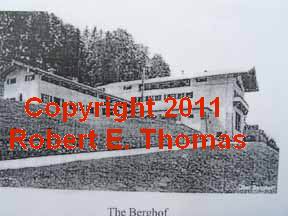
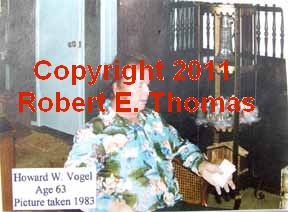
The Eagle's Nest, or the Berghof - which is correct?
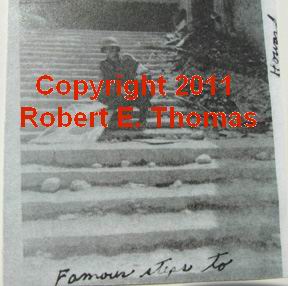 To this day, many Americans are confused by the names Berghof and
Eagle's Nest which are two separate places. The Berghof was located on a
plateau called the Obersalzberg which is on the route to the top of the
Kehlstein, the mountain where Hitler's tea house, called the Eagle's Nest, was built in 1938. To add to the confusion, Hitler had another tea house,
called Mooslahnerkopf, which was a short walk from the Berghof. The German
name for the Eagle's Nest is Kehlsteinhaus, which means House on Kehlstein
mountain. The Berghof was Hitler's Home.
To this day, many Americans are confused by the names Berghof and
Eagle's Nest which are two separate places. The Berghof was located on a
plateau called the Obersalzberg which is on the route to the top of the
Kehlstein, the mountain where Hitler's tea house, called the Eagle's Nest, was built in 1938. To add to the confusion, Hitler had another tea house,
called Mooslahnerkopf, which was a short walk from the Berghof. The German
name for the Eagle's Nest is Kehlsteinhaus, which means House on Kehlstein
mountain. The Berghof was Hitler's Home.
On April 25, 1945, British Lancaster Bombers escorted by American P-51
Aircraft from the 8th Air Force bombed the Berchtesgaden Obersalzberg
area. The Berghof was the first to be targeted, but due to its lower
position on a slope of the mountain - it was only partly damaged and its
Bunker remained Intact.
The Truth! US View
An Update on the Third Division Confrontation with Ambrose -
Spielberg over Historical Distortion in the Berchtesgaden Capture
by
Sherman Pratt, Lt Col US Army
(Ret), Company Commander,
Company L, 7th Infantry, WWII
and
Russ Cloer, Capt., I & R Platoon
Leader, 7th Inf. Regt., 3rd Inf. Div.,
VI Corp., 7th Army, US Army.
For some months the U.S. Army's Third Infantry Division vets have been attempting to get Historian Stephen Ambrose and filmmaker Stephen Spielberg (Saving Private Ryan) to set the record straight as to which unit arrived in Berchtesgaden first.
Subsequent to our earlier protests, we now find additional and unimpeachable authorities to support our contentions. We here pass these along to anyone interested in joining us in the struggle to correct the falsehood of Ambrose and Spielberg.
Allied Commander Dwight Eisenhower, and the CG of the 101st Airborne Division, General Maxwell Taylor, have both specifically credited the Third Division with the honor of entering Berchtesgaden first.
In his book, "Crusade in Europe", on page 418, Gen Ike wrote, "On May 4th....the Third Division captured Berchtesgaden," In General Maxwell Taylor's memoir "Swords and Plowshares", wrote, in part, on page 106, "On May 4th the Division (Taylor's 101st Airborne) received an order to move on Berchtesgaden....unfortunately a bridge was destroyed on our side of the autobahn so that the 3rd Division got to Berchtesgaden ahead of us on the after-noon of May 4th."
One would think that these two honored and reliable authorities would be more than adequate to result in a retraction and correction by Ambrose and Spielberg. But so far, in spite of continued complaints no such development has occurred. Again Hollywood demonstrates it is far more interested in box office receipts than historical accuracy.
There were two bomb hits, one on the East Wing and another bomb hit
between the Adjutancy and the Has Wachenfield. The Great Room and the
Second Floor remained intact. Most of the bombs landed beyond the Berghof.
The next day, April 26th, after the Bombing, the 910th
Mobile Antiaircraft tank Battalion Attached to the 101st Airborne
Division arrived at the Berghof.
Photo (left) taken on April 26, 1945 following the British Lancaster's bombing on April 25, 1945 of the Berchtesgaden/
Obersalzberg area, shows the Great Room and the second floor of Hitler's home the Berghof, INTACT. There were no bomb hits on the Great Room or the second floor.
The picture below to the left shows the Berghof when Howard arrived on April 26 1945.
Press photo on the right: An SS detatchment arrived on the morning of May 4, 1945 at the Berghof, looted and using gasoline lit the Berghof on fire, resulting in total destruction. It was reported later that the Third Infantry Division's soldiers were very disappointed because the violently burning fire stopped them from taking any trophy items.
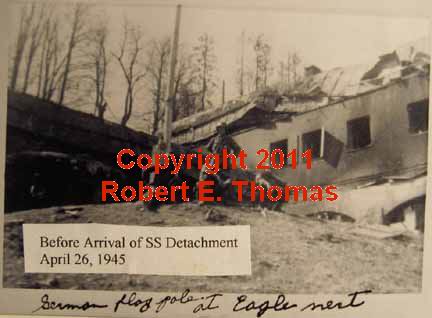
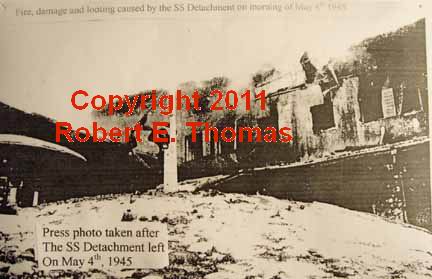
Howard W. Vogel and his unit, the 910th Mobile Antiaircraft tank
Battalion, Attached to the 101st Airborne Division were the first troops
to arrive there - early in the morning of April 26, 1945.
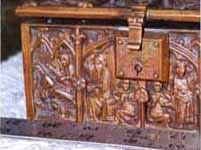 "There was a huge safe in the corner, I think it was probably three feet by four and possibly five feet high, maybe six feet high, but they had left the safe unlocked so we didn't have to blow that open."
"There was a huge safe in the corner, I think it was probably three feet by four and possibly five feet high, maybe six feet high, but they had left the safe unlocked so we didn't have to blow that open."
"This is just a short tape Mr. Thomas to let you know that the brass box and stamps I showed you and where I got them. I got this brass box and stamps the first day I was at Hitler's Eagle Nest in Berchtesgaden in 1945. I had this box and stamps ever since then. This is November 15, 1983. I am 64 years old. I am sure you will agree that the brass box by the design on the sides and so forth is quite a valuable antique."
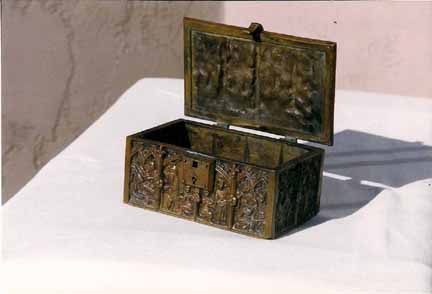
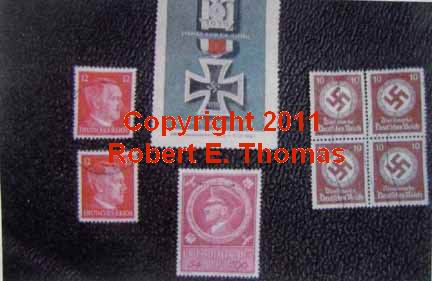
The following shows that the 910th Mobile Anti-Aircraft/Tank Battalion is attached to the 101st Airborne Division:
http://forum.valka.cz/viewtopic.php/p/87052#87052
Following is a series of events, and photographs, with Howard's written
comments on each, including documentation. All narrated by Howard W.
Vogel, an American Soldier with the 910th Mobile Antiaircraft tank
Battalion - Attached to the 101st Airborne Division
My name is Robert E. Thomas, my Army Serial
number is 39599758. I served in the 358 Regiment, 90th Division, 3rd Army
as a Combat Infantryman under General George S. Patton in the clearing of French and German villages to the Siegfried Line.
For more information search Google for "Robert Thomas
Ransbach Salt Mine Germany."
In 1977, I met Howard W. Vogel and later bought a
set of Silver Flatware from him that he took from Hitler's Home, the
Berghof on April 26, 1945. It belonged to Eva Braun. I was fascinated with
his experiences at Berchtesgaden and asked if I could tape them. He
agreed. The taping started in 1977 and ended in 1983. Some of the audio
CD's are very noisy, but with the 72 pages of printed transcriptions
everything is clear. There was a lot of
repetition. Howard was a great friend. I will miss him.
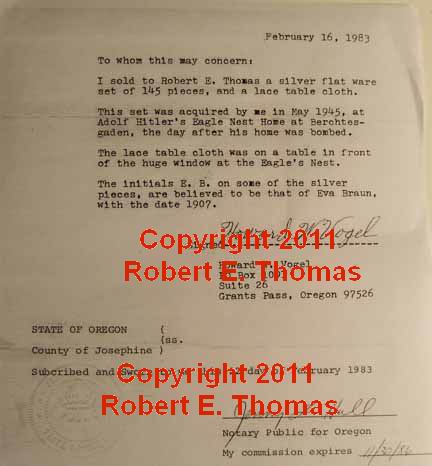
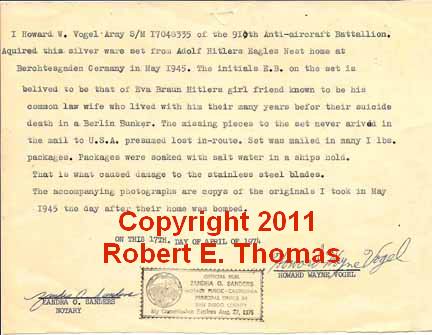 A notarized document enclosed, dated 1974,
describes Howard W. Vogel finding the set of Silver at the Berghof in May
1945. The month of May is also used on many photographs and documents, the
time period at the Berghof was April 26 to May 3rd, 1945. His narration
states the silver was taken on the first day there, April 26, 1945.
A notarized document enclosed, dated 1974,
describes Howard W. Vogel finding the set of Silver at the Berghof in May
1945. The month of May is also used on many photographs and documents, the
time period at the Berghof was April 26 to May 3rd, 1945. His narration
states the silver was taken on the first day there, April 26, 1945.
On April 26, 1945 at daybreak, one day after the
Allied bombing, the 910th Mobile Antiaircraft.tank Battalion arrived at
the Main Railroad Station at Berchtesgaden. There were two dozen men and
four trucks. They could see fires burning farther up the mountain, from
the bombing of the previous day.
The assignment of the 910th Mobile
Antiaircraft/tank Battalion was to locate and free a slave labor camp. The
camp was seen by a "Spotter" aircraft checking on the damage of
the Allied bombing.
They located the camp, one of the trucks using
chains pulled off the locked gate. German soldiers left only hours before.
One of the starved, grateful inmates tells Howard about the location of
"Hitler's Home" - the Berghof and the story and spot where
Goering's hidden underground Treasure Vault was located. Just up the hill
past the Berghof. The Vault area was covered over by grass and trees. The
inmate agreed to take them to the locations.
The 910th Mobile Antiaircraft/tank Battalion
attached to the 101st Airborne Division was the first Allied unit to reach
the Berghof - early on the morning of April 26, 1945. They remained in the
area until the morning of May 3rd, 1945 - when the entire unit left.
On the early morning of May 4, 1945, an SS
Detachment arrived and burned and looted the Berghof. Howard's original
photos taken before the arrival of the SS Detachment and later press
photos show effects of the looting, burning and destruction they did on
the morning of May 4, 1945.
That afternoon of May 4, 1945, the Third Infantry
Division reached the burning Berghof, set ablaze and looted by the SS
Detachment. They were followed by the French 2nd Armored Division that
evening. The following morning, May 5, 1945, the 101st Airborne Division, parent to the 910th Mobile Antiaircraft/tank Battalion arrived fifth.
Howard uses the word Eagle's Nest, instead of
Berghof.
Actually they were two different places. Confusion of the two words was
common among the military. He was never at the Eagle's Nest.
As they progressed slowly up the mountain, they
passed a large inn on the left, stopped and asked the innkeeper for
directions to Hitler's Home.

Hitler's small private rail terminal
The inmate then, directed them up the hill to the
Berghof. They approached a Private Small Train Station at the bottom of
the hill - it was built by the inmates. The inmate took Howard inside and
showed him a hidden room. It contained a communication center and an
entrance to a tunnel leading alongside the road to the Berghof.
Hitler could get off at the Small Private Rail
Terminal, enter the hidden room, board the small "Miner's"
car and ride all the way unseen through a tunnel to the Berghof, no one
would know he was there.
Howard describes the interior of the station and
its hidden room and com center. The capture of three German Soldiers
hiding in the underground com center. Maps showing the location of
American troops were still on the table.
Exploring the Secret Nazi Tunnels Under a German Vacation Town
by Luke Spencer July 28, 2015
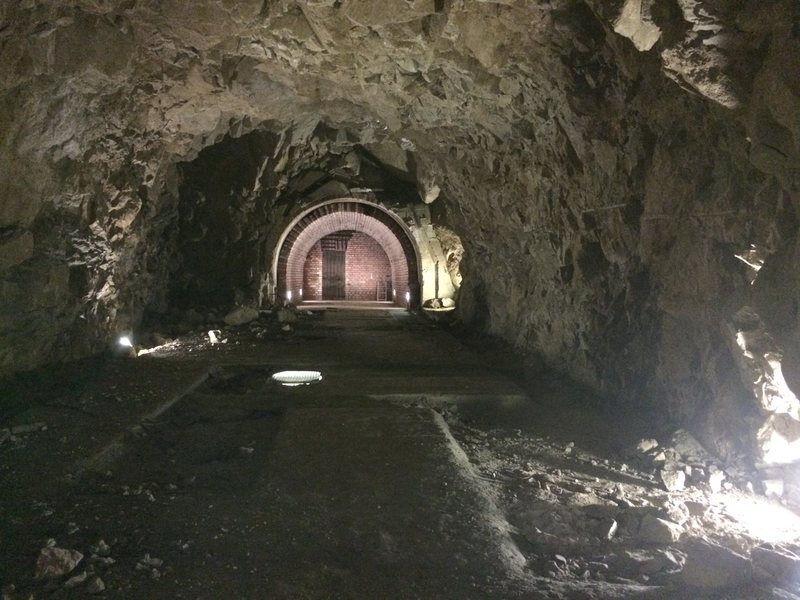
Tunnel system beneath the Platterhof Hotel, now part of the Documentation Centre exhibit. (Photo: Luke Spencer / Courtesy Atlas Obscura)
Deep in the mountains of Bavaria is a concrete doorway set into the side of the mountain. Even in the height of summer, the thick steel door is cool to the touch, and drips with condensation. From the edges of the door frame comes a chilling cold breeze. It isn't marked on any tourists guide maps, as the government would prefer that you had no idea that it exists.
Behind the steel door lies the underground secret bunker complex of Adolf Hitler...
-> Continue reading on Atlas Obscura
Howard describes the appearance of the exterior
and interior of the Berghof, smoke coming out of the bomb craters, food on
the tables. There were two cars present, both required a special cable
hoist to pull them into the steep garage.
He indicates they spent a week or more, driving
the cars around the countryside. It was actually eight days. They arrived
on the morning of April 26, 1945 - one day after the RAF bombing and
departed on the morning of May 3, 1945.
Hitler's white stucco two-bedroom home had two
floors with a wide terrace, library, and kitchen and double-car garage
carved into the mountain. Two cars were present, Hitler's black touring
Mercedes and Eva Braun's black Mercedes coupe - lipstick, perfume,
handkerchiefs and other feminine items were found in the coupe. The top
was down.
On that day, April 26, 1945, Howard W. Vogel
discovered and took three items:
1. An extremely rare set of J. A. Henckels
Solingen silver/gold flatware of 145 Pieces.
This set was acquired at Adolf Hitler's Berchtesgaden the day after it was
bombed by the allies.
The initials E. B. on some of the pieces are
believed to be those of
Eva Braun, the date of 1907 is the year Hitler's Mother was buried. This
rare set is documented with notarized statement, photos and audio tape.
2. A metal container with raised medieval figures
on the side, used as a stamp box. This was recovered from Hitler's
personal safe at Berchtesgaden. It measures 6 x 3.75 x 1.75 inches. Stamps
found in the box are shown here.
3. A large white lace table cloth measuring 77 x
56 inches. It sat on a table in front of the very large window at
Berchtesgaden.
Howard sent these items home.
The "Great Room" of the Berghof
consumed nearly the entire first floor. It was lavishly decorated with
Gobelin Tapestries, original paintings and sculptures. The floor was
covered by Persian Carpets. Most of the interior furnishings were intact,
including the large Crystal Chandeliers hanging over some of the tables.
The Chandelier and table near the huge window had a beautiful Lace
Tablecloth. Howard sent it home. The enormous two-inch thick,
motor-controlled window was blown open by concussion in the bombing - it
revealed a spectacular panoramic view of the surrounding area.
Hitler's workroom, lavishly furnished, known as
his Arbeitszimmer was on the Second Floor, next to his bathroom.
Eva Braun's apartment was next to Hitler's rooms.
At the foot of Eva's bed was a large hand-carved Cedar Chest. "As I
raised the heavy lid, there was a strong smell of cedar." There were
two diaries, a red one and a green one. Howard did not take the
diaries.
At the very bottom of the chest was another
smaller hand-carved one. It held a set of silver with gold overflay.
Several pieces had hand engraved initials EB and the date 1907. The year
1907 was the date Hitler's mother, Klara Hitler, died.
Klara Hitler, Hitler's mother, was diagnosed with
advanced Breast cancer on January 14, 1907, by their long-time physician,
Dr. Edward Bloch. Adolph kept constant watch, and helped with the
household duties, such as cooking and cleaning the floor. He anguished
over every moment of her pain and suffering.
Klara Hitler died December 21, 1907. Hitler was
devastated. The family physician, Dr. Edward Block, later reported that,
"He had never seen anyone so overcome with grief as Adolph Hitler at
the loss of his mother".
Adolph was eighteen and from then on, for the
rest of his life - he carried her photograph in his breast pocket.
Klara Hitler and Eva Braun were the two most
important women in Adolph Hitler's private life.
It is believed this set of Silver was purchased,
select pieces engraved and presented to Eva Braun by Adolph Hitler.
Eva Braun kept the set of silver in her cedar
chest, at the foot of her bed - along with her Wedding Dress.

All the knives have stainless steel
blades. When the silver was shipped home on freighters it was carried in
the ship's hold where it was exposed to saltwater. The exposure to salt
water caused corrosion on the knives steel blades.

A close up showing the corrosion.

A close up of the engraving on the knife blade

A close up of a fork handle

An enlarged section of the handle
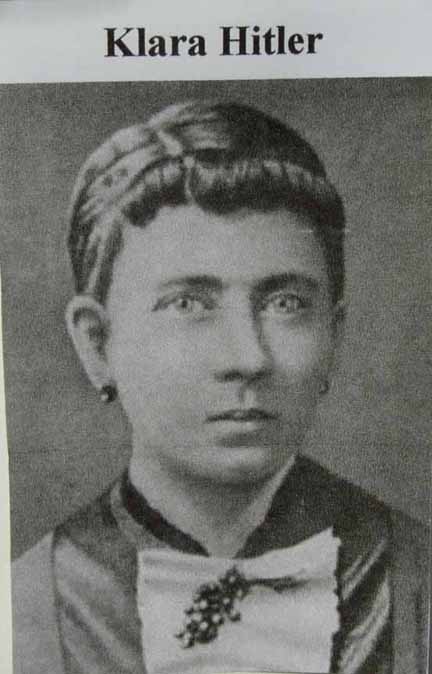
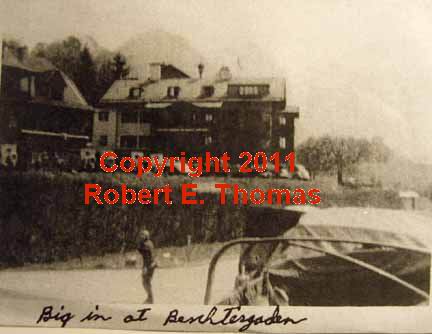

Bomb crater area
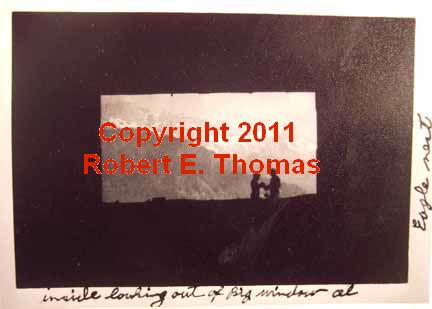
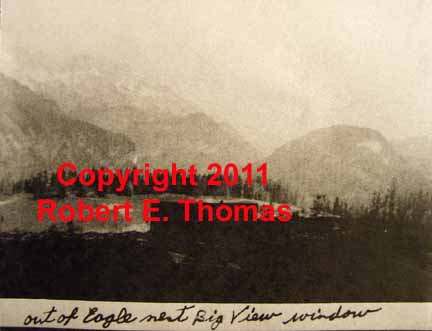
print this page
Go to Page 2
Copyright 2011 Robert E. Thomas
Computer services provided by Charles Pratt and Tim Holland at aowebs


 To this day, many Americans are confused by the names Berghof and
Eagle's Nest which are two separate places. The Berghof was located on a
plateau called the Obersalzberg which is on the route to the top of the
Kehlstein, the mountain where Hitler's tea house, called the Eagle's Nest, was built in 1938. To add to the confusion, Hitler had another tea house,
called Mooslahnerkopf, which was a short walk from the Berghof. The German
name for the Eagle's Nest is Kehlsteinhaus, which means House on Kehlstein
mountain. The Berghof was Hitler's Home.
To this day, many Americans are confused by the names Berghof and
Eagle's Nest which are two separate places. The Berghof was located on a
plateau called the Obersalzberg which is on the route to the top of the
Kehlstein, the mountain where Hitler's tea house, called the Eagle's Nest, was built in 1938. To add to the confusion, Hitler had another tea house,
called Mooslahnerkopf, which was a short walk from the Berghof. The German
name for the Eagle's Nest is Kehlsteinhaus, which means House on Kehlstein
mountain. The Berghof was Hitler's Home.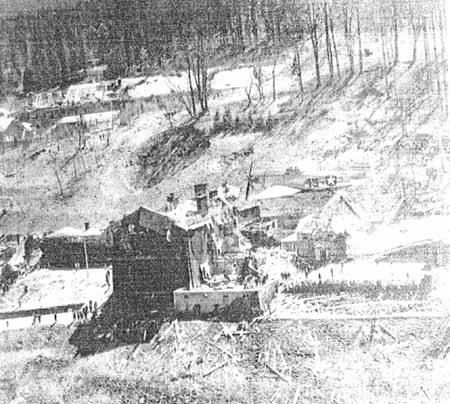


 "There was a huge safe in the corner, I think it was probably three feet by four and possibly five feet high, maybe six feet high, but they had left the safe unlocked so we didn't have to blow that open."
"There was a huge safe in the corner, I think it was probably three feet by four and possibly five feet high, maybe six feet high, but they had left the safe unlocked so we didn't have to blow that open."


 A notarized document enclosed, dated 1974,
describes Howard W. Vogel finding the set of Silver at the Berghof in May
1945. The month of May is also used on many photographs and documents, the
time period at the Berghof was April 26 to May 3rd, 1945. His narration
states the silver was taken on the first day there, April 26, 1945.
A notarized document enclosed, dated 1974,
describes Howard W. Vogel finding the set of Silver at the Berghof in May
1945. The month of May is also used on many photographs and documents, the
time period at the Berghof was April 26 to May 3rd, 1945. His narration
states the silver was taken on the first day there, April 26, 1945.
 Tunnel system beneath the Platterhof Hotel, now part of the Documentation Centre exhibit. (Photo: Luke Spencer / Courtesy Atlas Obscura)
Tunnel system beneath the Platterhof Hotel, now part of the Documentation Centre exhibit. (Photo: Luke Spencer / Courtesy Atlas Obscura)









